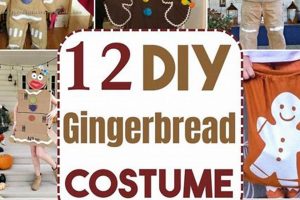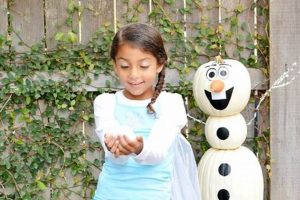A self-assembled Dorothy Gale attire allows for personalization and cost-effectiveness in recreating the iconic look from “The Wizard of Oz.” This approach often involves sourcing individual components, such as a blue gingham dress, ruby slippers (which can be embellished shoes), a white blouse, and a wicker basket, rather than purchasing a pre-made costume. It empowers individuals to tailor the outfit to their specific size, preference, and budget.
Creating one’s own version presents several advantages. It fosters creativity, provides an opportunity to recycle or repurpose existing clothing, and can result in a higher-quality, more authentic-looking ensemble. The freedom to select specific fabrics, embellishments, and accessories allows for nuanced interpretations and personalized touches. Historically, homemade costumes were the norm, reflecting resourcefulness and individual expression, values that continue to resonate with many costume enthusiasts.
The following sections will delve into specific elements and techniques involved in crafting a believable and memorable version, offering guidance on dress construction, footwear modification, and accessory procurement to aid in the realization of this celebrated character’s appearance.
DIY Dorothy Costume
The following tips provide essential guidance for constructing a successful homemade Dorothy Gale costume, ensuring a faithful representation of the character while allowing for individual creative expression.
Tip 1: Prioritize Gingham Fabric Selection: The blue gingham pattern is crucial to the costume’s recognizability. Opt for a smaller-scale gingham for a more classic look, and consider the fabric’s weight and drape to achieve the desired skirt fullness.
Tip 2: Modify Existing Dresses for Efficiency: Rather than constructing a dress from scratch, consider altering a pre-existing blue dress. This saves time and can reduce overall material costs.
Tip 3: Utilize Fabric Dye for Shoe Transformation: Transforming plain shoes into ruby slippers is achievable with fabric dye. Select a dye specifically formulated for the shoe’s material (e.g., fabric dye for canvas shoes, specialized paint for leather). Consider adding glitter for extra sparkle.
Tip 4: Emphasize White Blouse Detailing: The white blouse worn under the gingham dress contributes to the costume’s layered look. Opt for a blouse with subtle details such as puff sleeves or a Peter Pan collar to enhance its visual appeal.
Tip 5: Secure a Wicker Basket and Accessorize Appropriately: A small wicker basket is an integral accessory. Ensure the basket is appropriately sized for a child or adult and consider adding a small stuffed Toto dog for added authenticity.
Tip 6: Style the Hair for Authenticity: Dorothy’s hairstyle is characterized by pigtails or braids. Style the hair accordingly and consider using brown hair extensions or a wig if necessary to achieve the desired look.
Tip 7: Pay Attention to Makeup and Demeanor: While subtle, appropriate makeup enhances the costume’s overall effect. Focus on a natural look with rosy cheeks and lightly defined eyes. Projecting a youthful, innocent demeanor further contributes to the character’s portrayal.
By carefully considering these recommendations, one can successfully craft a memorable and recognizable version, capturing the essence of this beloved literary and cinematic character.
The subsequent sections will explore material sourcing, construction techniques, and accessory customization in greater detail, providing a comprehensive guide to creating a stunning self-made garment.
1. Gingham dress
The gingham dress constitutes a foundational element of any recreation. Its presence immediately signals the intended character, serving as a visual shorthand for Dorothy Gale. The color and pattern are inextricably linked to the character’s iconic image. A homemade version often hinges on either sourcing a suitable garment or constructing one from gingham fabric. The choice of fabric weight, gingham size, and dress style (e.g., pinafore versus a-line) significantly impacts the overall accuracy and aesthetic of the finished product. Absent a reasonable facsimile of this specific garment, the resemblance to the character diminishes considerably. For instance, a blue floral dress, while visually appealing, would not effectively communicate the intended character.
The practical application of understanding this connection is evident in material selection and construction or modification techniques. When purchasing fabric, individuals must prioritize the correct pattern and color. When modifying an existing garment, alterations should focus on replicating the silhouette and detailing of Dorothy’s dress. Real-world examples abound, from online tutorials demonstrating gingham dress construction to thrift store transformations highlighting the power of fabric dye and simple alterations. Recognizing the centrality of this garment informs every decision made during the construction or acquisition process, impacting budget, time investment, and ultimately, the success of the imitation.
In summary, the gingham dress is not merely a component; it is the linchpin of the entire ensemble. Challenges arise in sourcing accurate materials and achieving a flattering fit, but the importance of this element cannot be overstated. Its presence is critical to conveying the intended character, solidifying its position as the most important consideration when crafting a handmade adaptation. Without it, the costume loses its immediate recognition, rendering the remaining elements less effective.
2. Ruby footwear
The ruby footwear, a distinctive element of Dorothy Gale’s attire, holds considerable significance within the realm of self-assembled Dorothy Gale garments. Their visual prominence and symbolic weight contribute significantly to the overall success of any homemade rendition. The acquisition or creation of adequate ruby footwear represents a critical challenge in achieving a convincing imitation of the character.
- Material Selection for Replication
The creation of ruby footwear often necessitates careful material selection. Pre-existing shoes may be modified using fabric dye, glitter, or sequins to replicate the desired shimmering effect. Alternatively, custom-made shoe coverings can be fashioned from red fabric and embellished to achieve the iconic look. The choice of materials influences the durability, comfort, and visual authenticity of the final product. Examples include using canvas shoes for easy dyeing, employing glitter glue for a less permanent sparkle, or constructing custom-fit coverings using sequined fabric. These selections significantly impact the overall aesthetic and longevity of the homemade element.
- Embellishment Techniques and Their Impact
The application of embellishment techniq
ues plays a crucial role in transforming ordinary footwear into ruby slippers. These techniques range from simple glitter application to intricate sequin placement. The choice of method depends on the desired level of realism, budget constraints, and skill level. A poorly executed embellishment can detract from the overall costume, whereas a carefully applied design can elevate it significantly. Examples include uniform glitter application for a subtle shimmer, strategically placed sequins to mimic the original design, or the addition of bows or other decorative elements for increased visual appeal. - Comfort and Wearability Considerations
While visual accuracy is paramount, comfort and wearability should not be overlooked. The ruby footwear, particularly if heavily embellished, may present comfort challenges during extended wear. Modifications to the shoe’s interior, such as adding padding or selecting a comfortable shoe base, are essential. Blister prevention and proper fit are crucial for ensuring a positive costume experience. Examples include using gel inserts for added cushioning, selecting a shoe size that accommodates embellishments, or opting for slip-on shoe coverings for easy removal during periods of discomfort. These considerations ensure that the homemade recreation is not only visually appealing but also practical for wear.
- Symbolic Weight and Visual Recognition
The ruby footwear carries significant symbolic weight within the context of “The Wizard of Oz.” They represent Dorothy’s journey, her empowerment, and the magic within herself. Their visual presence immediately connects the costume to the source material, enhancing recognition and appreciation. Omitting or misrepresenting this element can significantly weaken the overall impact of a costume. Examples include viewers immediately recognizing a Dorothy costume based solely on the presence of these shoes or the disappointment expressed when the recreation lacks this crucial element. The strong association solidifies the footwear’s place as a vital and instantly recognizable component.
The ruby footwear, therefore, represents a crucial element in any successful self-assembled adaptation. From material selection to embellishment techniques, and from comfort considerations to symbolic representation, each facet contributes to the overall impact. Their presence substantially elevates the authenticity and recognizability, underscoring their importance in achieving a successful recreation.
3. Wicker basket
The wicker basket functions as a key accessory for a self-assembled Dorothy Gale attire, contributing significantly to the costume’s overall authenticity and immediate recognizability. Its inclusion directly influences how effectively the homemade costume conveys the intended character. The basket serves as a practical prop, completing the visual narrative and providing context. Without the basket, the attire lacks a crucial element that ties the entire ensemble together. For example, a blue gingham dress and ruby slippers, though essential, are incomplete without the presence of the basket, which immediately signals Dorothy’s character. Conversely, a person carrying a wicker basket paired with more generic clothing can still evoke the character of Dorothy, albeit to a lesser extent. Thus, the basket holds considerable weight in visual character representation.
The practical application of this understanding manifests in several ways. When assembling a recreation, sourcing an appropriately sized and styled wicker basket becomes a priority. Variations exist in basket shape, size, and construction, so selection must be guided by reference images and practical considerations. For instance, larger baskets might prove cumbersome for children to carry, while smaller baskets might not adequately accommodate a stuffed Toto dog, a common accessory. Furthermore, the basket can be customized through paint, fabric lining, or decorative elements to enhance its visual appeal or reinforce the character connection. Real-world examples include craft enthusiasts creating bespoke basket liners with gingham fabric or applying antique stains to achieve a weathered look, thus increasing the basket’s authenticity.
In conclusion, the wicker basket represents a necessary component for effective visualization. Its absence detracts from the overall impact of a costume. Challenges may arise in sourcing the perfect basket or customizing it to match specific preferences, but the effort is worthwhile given the basket’s significant role in the immediate identification of the character. The attention of the basket, alongside with dress and footwear, will lead to a complete package and accurate character representation.
4. Blouse style
The style of the blouse worn beneath the gingham dress significantly impacts the overall effectiveness of a self-assembled Dorothy Gale attire. While the gingham dress and ruby slippers provide immediate recognition, the blouse contributes a layer of detail that enhances the costume’s authenticity. The specific style choices, such as collar type, sleeve length, and fabric texture, can either elevate the costume’s perceived accuracy or detract from it. For example, a plain, modern t-shirt worn under the dress would undermine the intended historical context and diminish the visual impression, whereas a white blouse with a Peter Pan collar and puffed sleeves more closely aligns with the character’s traditional depiction.
The practical application of this understanding is evident in the garment selection process. Individuals crafting a Dorothy Gale costume should prioritize blouses that reflect the early to mid-20th century aesthetic. Thrift stores, vintage clothing retailers, and online marketplaces often provide a range of options. Considerations include the blouse’s material (cotton or linen are preferable), its embellishments (lace or subtle embroidery can add visual interest), and its fit (a slightly loose fit complements the dress’s silhouette). Real-world examples include costume designers meticulously researching period-appropriate blouses and replicating their features, as well as hobbyists finding vintage blouses and adapting them to fit their specific needs. The choice of blouse serves not merely as an afterthought but as a carefully considered component of the total assemblage.
In summary, the style of the blouse, though often overlooked, functions as a critical supporting element in a self-assembled Dorothy Gale attire. Its presence amplifies the overall effect and enhances the perceived accuracy of the imitation. Challenges may include locating suitable vintage blouses or replicating period-accurate styles, but the investment of time and effort yields a more compelling and authentic outcome. The blouse, therefore, merits careful attention in the pursuit of a truly successful recreation.
5. Hair styling
Hair styling is a critical component of a self-assembled Dorothy Gale attire, functioning as a visual cue that directly influences the costume’s recognizability and adherence to the character’s established image. The specific hairstyle, characterized by braids or pigtails, acts as a shorthand for the character, providing immediate visual context. The absence of this specif
ic hairstyle, or the substitution with a modern or stylistically inappropriate alternative, can diminish the intended character’s recognition, lessening the impact of the entire composition. For example, long, flowing hair, while aesthetically pleasing, fails to convey the specific innocence and youthful character as effectively as braided pigtails. Thus, the selection and execution of hair styling holds substantial weight in the final impression.
Practical application of this understanding is evident in both costume construction and performance. Recreations should prioritize accurate hairstyling techniques, either by styling the individual’s own hair or by utilizing a wig styled appropriately. Tutorials on braiding techniques and wig styling are readily available, providing guidance on achieving the desired look. Examples from theatrical productions and cosplay events highlight the attention given to hair styling; even meticulously crafted dresses and ruby slippers lose impact when paired with inappropriate hairstyles. Color also matters, with brown being the quintessential color for dorothy gale and can be addressed by wigs or hair dye (temporary). This, ultimately enhances realism.
In summary, hair styling presents a significant factor for effective self-assembly. Failure detracts on costume’s final visual recognition and performance. While challanges will araise for individuals that have shorter or other unique hair styles, it is necessary for either wig implementation or hair style expansion and alteration. With careful effort, final recognition is more likely to be recognized with the final effect.
Frequently Asked Questions
The following questions address common inquiries and misconceptions regarding the self-assembly of Dorothy Gale attire, providing concise and informative answers to guide the creation of an accurate and recognizable costume.
Question 1: What is the most critical element of a DIY Dorothy Costume?
The blue gingham dress is the most critical element. Its distinctive pattern and color are instantly recognizable and fundamental to the character’s visual identity.
Question 2: Can any red shoes be used for the ruby slippers?
While any red shoes can be used, the effect will be diminished. Canvas shoes that can be dyed and embellished with glitter offer the best balance of cost-effectiveness and visual accuracy.
Question 3: Is a petticoat necessary for the dress?
A petticoat is not strictly necessary, but it adds volume to the skirt, enhancing the overall silhouette and contributing to a more authentic appearance.
Question 4: What material is best for the white blouse?
Cotton or linen are preferable materials for the white blouse. They offer a period-appropriate aesthetic and are comfortable to wear.
Question 5: How important is the dog Toto to the costume?
While not mandatory, a small stuffed Toto dog significantly enhances the recognizability of the costume and provides an additional visual element.
Question 6: Is it more cost-effective to make or buy a Dorothy costume?
Generally, a self-assembled costume is more cost-effective, allowing for material sourcing and customization to fit a specific budget. However, the time investment must be considered.
In summary, achieving a successful rendition requires careful attention to key elements, material selection, and budget considerations. Balancing cost-effectiveness with visual accuracy remains paramount.
The following content delves into advanced techniques for achieving superior visual fidelity in constructing each component.
Conclusion
This exploration has detailed the essential components and considerations for creating a self-assembled Dorothy Gale attire. Emphasis has been placed on the gingham dress, ruby footwear, wicker basket, blouse style, and hair styling as critical elements influencing the costume’s recognizability and effectiveness. Understanding the adjectival and noun-centric nature of the term guides the focus towards characteristics and visual details rather than actions or processes. Prioritizing material selection, construction techniques, and accessory accuracy are vital for achieving a compelling and authentic character portrayal.
The ability to effectively replicate a recognizable version rests upon a thorough understanding of these elements and their interrelation. Continued refinement of techniques and a focus on detail will further enhance the fidelity of self-made garments. Attention to these factors ensures the creation of a memorable and impactful recreation.







